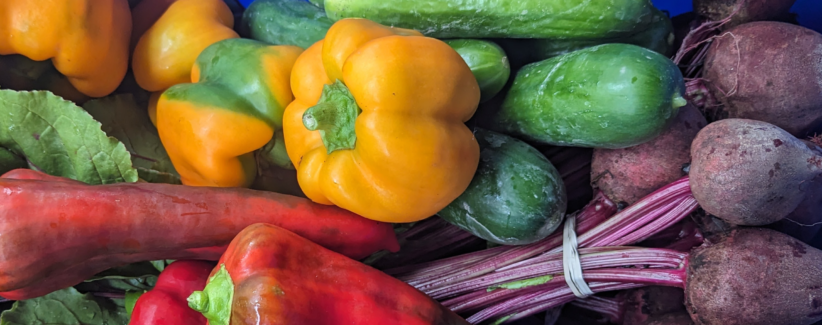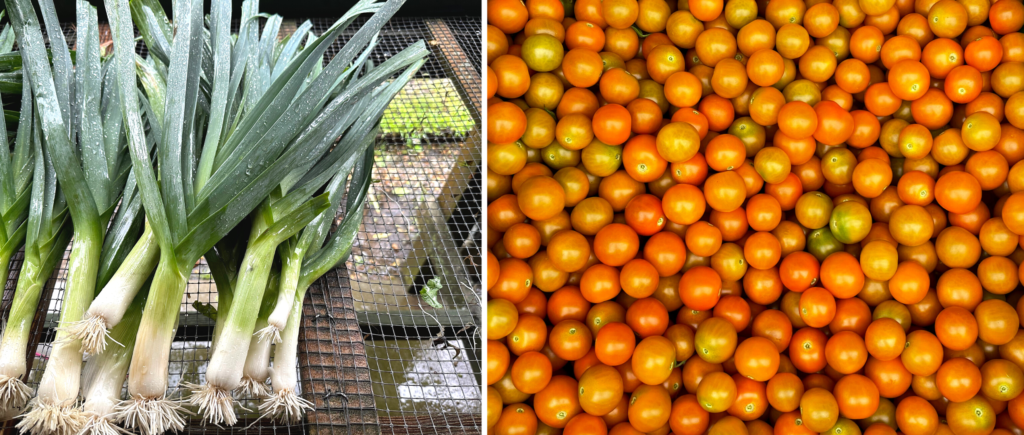On Servings & Pounds: Measuring Impact on the Farm

What’s 115,000 pounds, but just a tiny piece of the big picture? The weight of our annual harvest!
Numbers command attention. They tell a story. And poundage in particular is a prominent metric on the farm.
Accurately recording the weight of each harvest helps us understand production rates; track patterns in crop performance; gauge the toll that pests, disease, or extreme weather take during a season; and communicate our impact.
“Weight as a standard for measuring agricultural production is pretty ubiquitous, partly because we’re a data-obsessed society,” said Allison Goodwin, Director of Operations at Gaining Ground. “Instead of focusing on qualitative metrics, we want to tally things.”
Yet more and more, Gaining Ground is bringing other markers of success into the mix, such as individual servings donated, organic matter in the soil, our environmental impact, and—most importantly—the feedback of people who receive our donations. In time, Allison said the farm would even like to record the nutrient density of our crops.
“There are so many different ways to draw out the benefits of what we do,” Allison said. “Starting this year, we tried to drill down and get a lot more granular about individual food servings, in particular.”

How do you measure servings from a harvest? The prevailing approach has been to multiply the average weight of your overall harvest by four, and use that number. So 100 pounds of crops equals 400 servings of food. But not all crops weigh the same.
To learn a more precise approach, Allison turned to our friends at Community Harvest Project (CHP) in North Grafton, who have been framing their impact in terms of servings for a long time. Crop by crop, CHP maps their harvest against USDA guidelines for individual servings. Although it takes a bit more time, it’s worthwhile, Allison said, because the method accounts for more nuance and captures impact more precisely. For instance, it helped us discover that Gaining Ground was producing about 10,000 more annual servings than we previously measured.
Allison joined Gaining Ground in 2017, and over the course of six seasons has seen annual production rise significantly, hit a pinnacle of 127,000 pounds in 2020, then ebb to 115,000 pounds, where it’s held steady. That ebb was the starting point for a bigger conversation about metrics on the farm, she said, as people confronted feelings of disappointment. In reality, the decrease in poundage was complex—owing largely to historic flood rains in 2021, but also to our choice to replace some heavy crops, like butternut squash, with lighter ingredients requested by the people we serve, including nutrient-dense leafy greens, cassava, hot peppers, and cilantro.
When we size up a season by weight, we may create unreasonable expectations—after all, farmers are contending with natural, uncontrollable forces. It may even create the impression that production is down when we’re just growing more crops that weigh less. Take microgreens, for instance, which we brought into production last winter. They weigh practically nothing—yet they are nutritional powerhouses that pack potent flavors. Arriving as they do in deep winter, microgreens also provide something a scale can’t capture.

“I believe our clients welcomed the micro-greens as a sign of spring, a sign of hope,” said Jill Tsakiris, Program Manager at Open Table in Maynard, in May 2023. “The greens were so visibly different from the root vegetables, winter squash, and cabbage we have been providing lately. The past few weeks have been tough—weather wise, but also with the ending of pandemic emergency benefits for many of our clients. So the microgreens provided a much-needed psychological lift.”
Allison said the metric that moves her most is what people have to say about the produce we donate. One patron of Women’s Lunch Place in Boston remarked that the vegetables in her meal tasted like they were grown in her grandmother’s garden. Another told the chef that the produce was so fresh, it tasted like it just came out of the ground. “I told her it did,” the chef said.
“When people share these messages, it’s about more than just the freshness, or the calories and pounds,” Allison said. “It’s memory. There’s an emotion there. A feeling that they’re worthy of receiving the highest-quality food.”